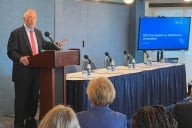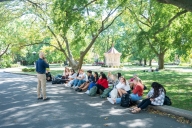You have /5 articles left.
Sign up for a free account or log in.
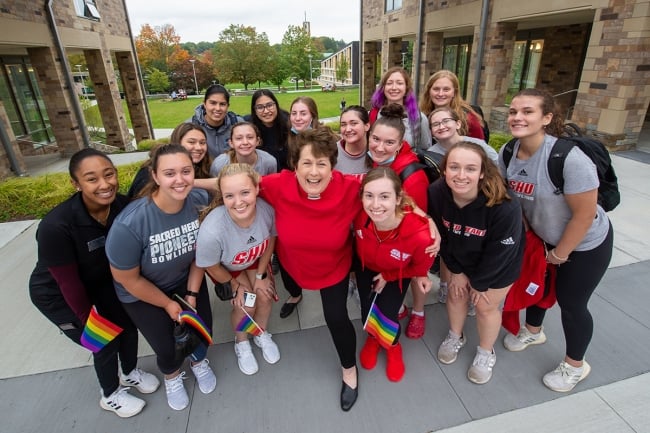
Students and a chaplain at Sacred Heart University celebrated Coming Out Day and honored the university’s LGBTQ+ community.
Sacred Heart University
Kyle Humphreys was pursuing a career in human resources and didn’t have a professional background in higher education when a former professor suggested he apply for a new position at Sacred Heart University.
The small Catholic college in Fairfield, Conn., was breaking new ground with the newly created position of manager of LGBTQ+ affairs. Mark Congdon, an assistant professor of communication at Sacred Heart, thought Humphreys might be a perfect fit for the role.
Humphreys was intrigued and surprised to hear that a religious institution even had such a position. He attended the College of Saint Rose, a Catholic institution in New York where Congdon formerly taught. It had no programs focused on LGBTQ+ affairs, much less a leadership position to direct such programs.
“All my life, I’ve wanted to contribute to something larger than myself,” Humphreys said. “Being a queer and trans masculine person, I felt like I had a lot to offer to this role with my lived experiences. Having transitioned in college, I know how stressful and challenging that can be.”
Humphreys applied for the position last August and was hired in September. He moved to Connecticut a few weeks later and started working at Sacred Heart in early October, just in time to serve as master of ceremonies for the college’s annual Coming Out Day celebration on Oct. 9. He was joined by university president John Petillo, who has openly voiced support for LGBTQ+ students.
“Equality is rooted not in laws, but firmly in the hearts and minds of the community, this community,” Petillo said at the event. “We gather to unequivocally profess our support for each of our sisters and brothers. We refuse to be bullied into silence.”
The position, and the recent establishment of a Sexuality and Gender Equity Center, or SAGE, which Humphreys will oversee, is part of a larger initiative by university leaders to boost diversity, equity and inclusion efforts.
Maurice Nelson, Sacred Heart’s chief diversity officer and head of the Office of Inclusive Excellence, said these efforts are part of the university’s Catholic-rooted mission to “love and care for the whole person.”
“We are a Catholic institution. But we have so many people who work and are educated here who are not Catholic, or even Christian,” Nelson said, noting that only about 60 percent of the estimated 1,700 members of each freshman class identify as Catholic. “We have a responsibility. We committed at the inception of the institution to support everyone holistically.”
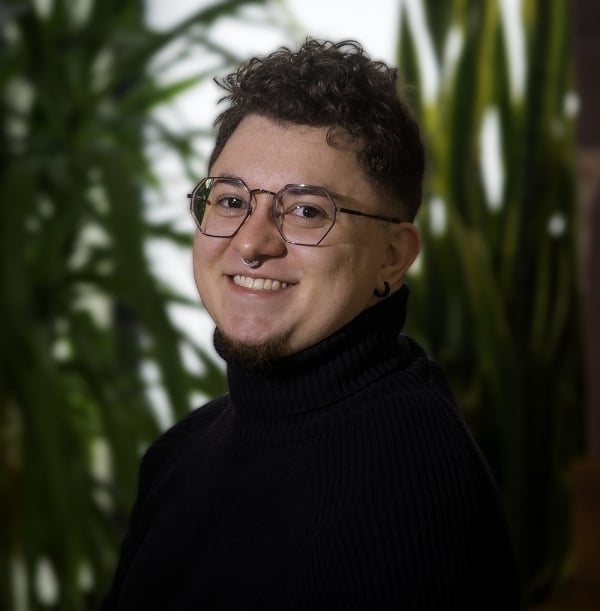
Humphreys joined the staff at Sacred Heart University in October 2023.
Sacred Heart University
Humphreys noted that not many colleges are launching or promoting similar new DEI initiatives, and some are even backing away from or reversing them entirely in the wake of the Supreme Court decision on affirmative action in college admissions and growing opposition to such programs among largely Republican state lawmakers .
“They’re seen as a threat or they’re becoming aggressively challenged,” Humphreys said of DEI and LGBTQ+ support programs. “But Sacred Heart doesn’t seem to have shied away from that at all.”
A Small, Like-Minded Community
Sacred Heart isn’t the first Catholic college to open an LGBTQ+ students’ center and hire a designated LGBTQ+ affairs staff member—Georgetown University established its center in 2008. Sacred Heart’s remains one of few, however. Others include centers at Marquette University in Milwaukee and Santa Clara University in Silicon Valley, both located in urban, progressive communities.
Data from LGBTQ+ advocacy groups tracking college resource centers suggest that the majority of public and private secular institutions lack such services. According to the LGBTQ Centers Directory, created by the Calamus Foundation, Pennsylvania State University; the University of California, Riverside; and the University of Oregon, there are only 183 campus LGBTQ+ centers for the nearly 6,000 colleges and universities in the U.S.
But Jonathan Coley, an Oklahoma State University professor who has studied how Catholic and Christian institutions are addressing LGBTQ+ issues, said these centers are slowly becoming more common. Some colleges may also employ LGBTQ+ affairs staff members within a larger women’s center or DEI department.
“Research shows that LGBTQ resource centers have positive impacts on students,” Coley said in an email. “Not only do they help educate their larger campus communities about LGBTQ issues, but they also provide a place of belonging for LGBTQ students who may feel isolated on their campuses.
“I attended graduate school at Vanderbilt University, which has a dedicated LGBTQ student center, and that center helped me quickly find a community,” he said.
Student and Alumni Support
Nicole Sperling, a senior at Sacred Heart and president of the Gender and Sexuality Alliance club, or GSA, was one of a few students on the university’s LGBTQ Task Force. She was a leading advocate for the establishment of both Humphreys’s position and the SAGE Center, which serves as an educational resource on LGBTQ+ issues as well as a hangout spot for students.
Sperling said when she arrived at Sacred Heart as a freshman in 2020, the university had few programs in place to promote diversity, equity and inclusion. It wasn’t a hostile campus for LGBTQ+ students, she noted, but members of their community were hesitant to advocate for queer representation.
“People don’t like to step outside of their comfort zone,” she said.
But a campus Multicultural Center, which opened in 2020, and the new SAGE Center, which opened in 2022, are changing that and creating space for people to feel comfortable being themselves and for others to learn more about LGBTQ+ culture.
Sperling hopes people on campus will feel less hesitant discussing LGBTQ+ issues or asking questions about the LGBTQ+ community without fear of misspeaking or offending someone.
“People know that they can make a mistake because others are willing to educate them, so more people are becoming more open-minded,” she said.
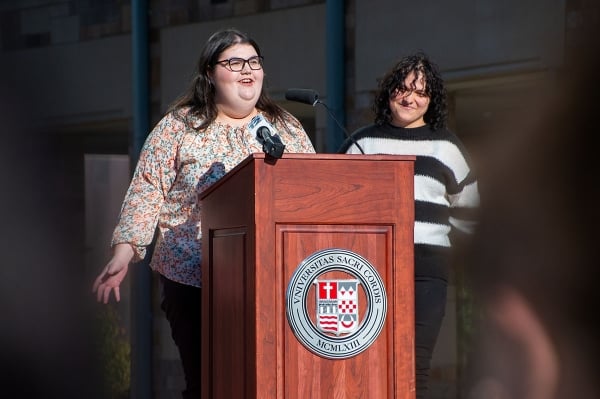
Nicole Sperling, Sacred Heart senior and president of the Gender and Sexuality Alliance, presented at the university’s Coming Out Day Ceremony on Oct. 9.
Sacred Heart University
Alice Ferreira, a vice president on the university’s alumni board, said she and other alums have been involved in ongoing conversations about DEI efforts and that she “applauds the bold steps” university leaders have taken.
The SAGE Center and its efforts are heavily influenced by input from student organizations such as GSA. So far they have pushed for and gotten university leaders to establish all-gender restrooms and gender-inclusive housing on campus.
Ferreira also hopes the SAGE center and LGBTQ+ student organizations will partner with alumni to promote LGBTQ+ advocacy through newsletters and homecoming events.
The Office of Inclusive Excellence is also working to create an infrastructure for collecting demographic data on the LGBTQ+ population. Sacred Heart administrators are only aware of the 80 out LGBTQ+ students who are active members of the GSA. But those data are unrepresentative, as not all queer students are involved with the LGBTQ+ student organization.
Sperling knows the center is starting off small, but she hopes similar work continues after she graduates.
“There’s power in numbers. So the louder that we are, the more people will know about us—that we’re here and we’re staying,” she added.
Little Public Pushback—So Far
Sperling and Ferreira both noted that they have seen little to no pushback from students, staff or alumni since Humphreys’s position was introduced. There has been some opposition to general inclusion efforts from outside groups, however.
Some Catholic colleges have had more problematic experiences with LGBTQ+ inclusion efforts—Saint Mary’s College, for one, a Catholic women’s institution in Indiana, recently reversed its decision to consider transgender women for admission after significant opposition from the local bishop and various students and alumnae.
Nelson, the diversity officer, said the lack of significant opposition to Sacred Heart’s initiatives is due to the institution’s formation in 1963 during the Second Vatican Council, which supported lay university governance, which means the university is not sponsored by a religious congregation, institute or diocese.
“Even though we are deeply rooted in that faith, there’s always been this openness and understanding that we evolve with time,” said Ferreira, the alumni board member. “And I’m Class of ’91, so this is how far back it goes.”
Despite the absence of opposition so far, Humphreys isn’t under the illusion that everyone on the campus supports his work.
“I expect a lot of pushback,” he said. “And even now, doing this interview, I know that it draws more attention to me and puts a target on my back … but that doesn’t mean it’s not worth doing.”
Nelson is confident Petillo, the president, will continue to support the SAGE Center and Humphreys’s role despite any opposition.
“He affirms our mission," Nelson said. “He says, ‘This is what we stand for. Take it or leave it,’ and he’s pretty adamant about that.”
Francis Origanti, senior vice president of mission and culture at Sacred Heart, agreed.
“SHU plays an important role in shaping today’s modern, vibrant Catholic intellectual tradition, where faith and reason coexist,” he said in an email. “We see a call to embrace social justice as part of our mission, one that requires discernment, reading the signs of the times and properly celebrating the diversity in our midst as a gift.”






